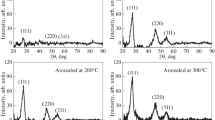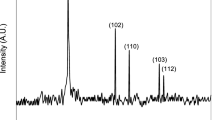Abstract
Amorphous selenium thin films deposited under vacuum have been doped with iodine either during or after crystallisation. It is shown that when the films are first crystallised at 363 K for 6 h and then submitted to iodine atmosphere at 363 K for 1 h, the structural properties of the films are not modified while their conductivity increases by a factor of 8. Iodine atmosphere induces post crystallisation of amorphous selenium films even at room temperature by increasing the selenium atom mobility at the surface of the films, which induces growth of crystalline spherulites. With annealing, when the heating rate is high (>15 K/min), constraints appear in the films, the density of spherulites increases and the films are inhomogeneous. When the heating rate is small and constant (1 K/min) the interaction between iodine and selenium takes place all over the sample and there is only a small density of small spherulites, while the crystallisation of the whole sample is more homogeneous. XPS and microprobe analysis that the iodine is equally repartitioned in the selenium film show it. Moreover there is a mixture of neutral iodine andS I3 − as shown by XPS and Raman studies. The high crystalline quality of the films can explain the high conductivity (>10−3 Ω−1 cm−1) of these selenium doped films
Similar content being viewed by others
References
K. S. Kim and D. Turnbull, J. Appl. Phys. 44 (1973) 5237.
D. Turnbull Idem., ibid. 45 (1974) 3447.
G. Gross, R. B. Stephens and D. Turnbull, ibid. 48 (1977) 1139.
J. P. Audiere, CH. Mazieres and J. C. Carballes, Journal of Non-Crystalline Solids 34 (1979) 37.
E. A. Chatterjee and S. P. Sen gupta, Journal of Materials Science Letters 5 (1986) 559.
N. G. Patel, B. H. Lashkari, C. J. Panchal and K. K. Makhija, Cryst. Res. Technol. 29 (1994) 859.
G. Safoula, J. C. Bernede, A. Latef, E. Rzepka and M. Spiesser, Mater. Chem. and Phys. 20 (1988) 571.
J. C. Bernede, G. Safoula, R. Messoussi, A. Bonnet and A. Conan, J. Phys. Chem. Solids 50 (1989) 1159.
R. Messoussi, J. C. Bernede, G. Safoula, E. Rzepka and M. Spiesser, Physica. Stat. Sol. (a) 123 (1991) 175.
J. Rowlands and S. Kasap, Physics Today,November 1997, 24.
J. W. Boag, Xeroradiography, Phys. Med. Bio1 18 (1973) 3.
R. A. Zingaro and W. C. Cooper, Selenium (Van Nostrand/Reinhald Co., New-York, 1974).
C. H. Champness, J. Appl. Phys. 32 (1987) 919.
H. P. D. Lanyon, Phys. Stat. Sol. (a) 2 (1970) 287.
S. Poganski, Zeitschnift Für Physik 134 (1953) 469.
E. F. Kaelble, “Handbook of X-Rays,” (McGraw-Hill, New-York, 1967).
DR. Briggs and M. P. Seah, Pratical Surface Analysis Vol. 1–Auger and X-Rays Photoelectron Spectroscopy (John Wiley & sons, 1990) p. 543.
P. S. Carroll and J. S. Lannin, Phys. Rev. B 27 (1983) 1028.
G. Lucovsky, R. C. Keezer and E. Burstein, Solid State Communications 5 (1967) 439.
A. G. Maki and R. Rorneris, Spectrochimica Acta 23A (1967) 867.
W. F. Howard and L. Andrews, Journal of Raman Spectroscopy 2 (1974) 447.
L. Andrews, E. S. Prochaska and A. Loewenschuss, Inorg. Chem. 19 (1980) 463.
M. I. El-azab and C. H. Champness, IEEE Trans. Elect. Dev. ED-27 (1980) 255.
J. C. Bernede, H. Hadouda, S. J. Li, H. Essaidi, J. Pouzet and A. Khelil, J. Phys. III 6 (1996) 1697.
J. P. Audiere, C. Mazieres and J. C. Carballes, Journal of Non-Cystalline Solids 27 (1978) 411 (a) and 34 (1979) 37 (b).
Y. S. Chiang and J. K. Johnson, J. Appl. Phys. 38 (1967) 1647.
M. B. Ijanjua, J. M. Toguri and W. C. Cooper, J. Can. Phys. 49 (1970) 475.
M. K. Agarwual and V. V. Rao, Cryst. Res. Technol. 24 (1989) 1215.
C. H. Champness and R. H. Hoffman, Journ. Non-Crystalline Solids 4 (1970) 138.
J. Baglio, J. Sol. Sat. Chem. 49 (1983) 166.
K. Zellama, P. Germain, S. Squelard and J. C. Bourgoin, J. Appl. Phys. 50 (1979) 6995.
G. Fleury, C. Lhermittte and G. Viger, Journ. Non-Crystalline Solids 46 (1981) 427.
J. Heleskivi, T. Stubb and T. Suntola, J. Appl. Phys. 40 (1969) 2923.
K. W. Plesner, Proc. Phys. Soc. B64 (1951) 671.
Author information
Authors and Affiliations
Rights and permissions
About this article
Cite this article
D'Almeida, K., Napo, K., Safoula, G. et al. Crystallisation of selenium thin films doped with iodine after evaporation. Journal of Materials Science 35, 2985–2991 (2000). https://doi.org/10.1023/A:1004730811005
Issue Date:
DOI: https://doi.org/10.1023/A:1004730811005




